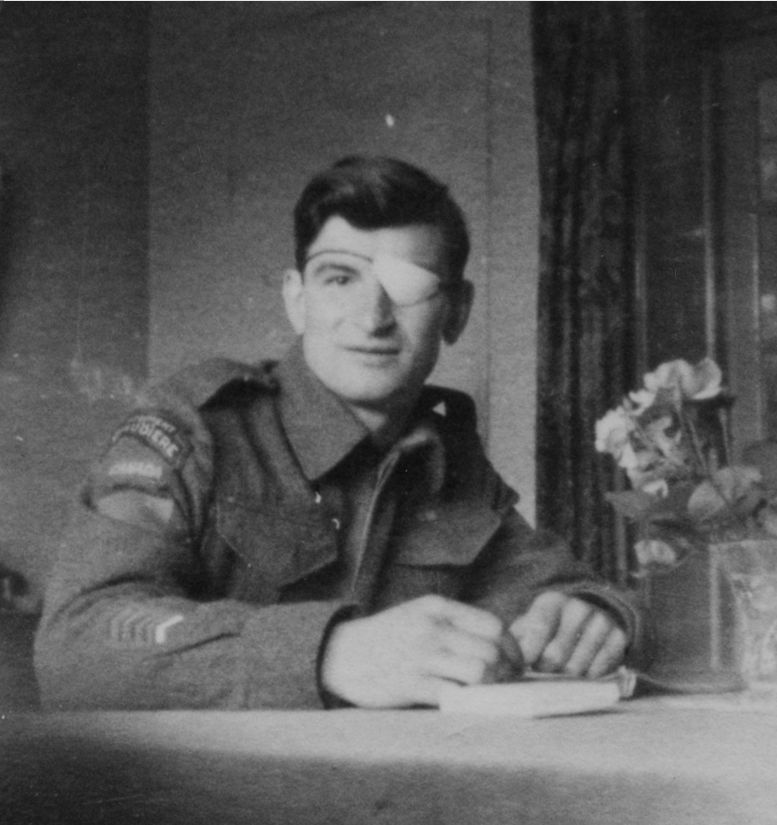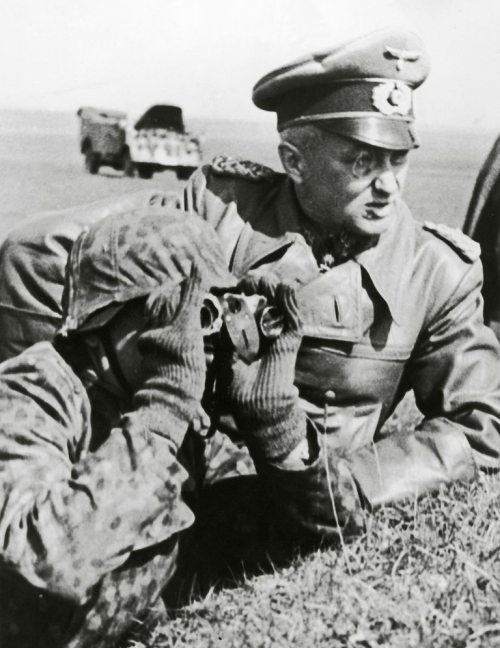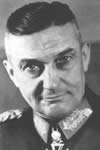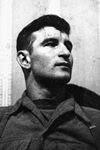The First Attack by British Parachutists
By A.J. Wilson.
The War Illustrated, Volume 10, No. 248, Page 547-548, December 20, 1946.
On February 10, 1941, a small band of determined men dropped by parachute from six R.A.F. aircraft through a starlit sky in Souther Italy. Their mission was to demolish an important aqueduct not far from Monte Vulture, a 4,000-foot peak in the lonely border country between the provinces of Campagna and Apulia. In the light of the great Allied airborne operations which were to follow, this small raid has been almost forgotten. But on this cold, clear winter's night, amid snow-capped mountains, these men made history – they were the first British airborne troops to go into action in the Second Great War.
The operation was only partly successful. The damage done to the aqueduct had a negligible effect on the course of the war in the Mediterranean, and the gallant parachutists finished up in prison camps. They did not, however, lose their liberty in vain. This first practical experiment in the employment of British parachute troops showed the extent to which the joint work of the Army and R.A.F. had developed within a few months, and it laid the foundations for that co-operation between the two Services which led to such epic events as the leap over the West Wall on D-Day, the Arnhem operation and the airborne landings on the east bank of the Rhine.
Only eight months before – on June 22, 1940 – the Prime Minister, Mr. Churchill, had given instructions to his Chief of Staff for the training of "a corps of at least 5,000 parachute troops". Major J. F. Rock, Royal Engineers, was given charge of the military organization; and shortly afterwards the Central Landing Establishment, cradle of British airborne forces, was formed under the command of a R.A.F. officer, Group-Captain L. G. Harvey, to train men for this new type of warfare. Major Rock found ready co-operation among his Air Force colleagues, chief of whom were Wing-Commander L. A. Strange, D.S.O., M.C., D.F.C., and Wing-Commander Sir Nigel Norman, Bt., C.B.E.
What the Target Meant to Italy
All through the summer and autumn rigorous training went on. It was the R.A.F.'s task to produce the parachute equipment, to evolve the methods of dropping, and to teach the troops their air technique. Meanwhile, the Army studied the special organization for fighting on the ground and the weapons and tactical training of the parachutists. Shortly after Christmas 1940, a sufficient number of troops had been trained to high enough pitch to make a small-scale operation possible. Targets were considered, and it was decided that the blow should be against the Italian aqueduct near Monte Vulture – 1,800 miles from Britain.
The strategic importance of the aqueduct to the Italians was considerable. A London firm of engineers had suggested the target and provided important relevant details. Its destruction was obviously a task for ground forces, as precision bombing had not then been sufficiently developed to give a reasonable chance of hitting it at its vital points. Spanning a small stream, the Tragino, the aqueduct carried the main water supply for the whole of the province of Apulia, with its thousands of industrial, dockyard and armament factory workers in Taranto, Brindisi, Foggia and Bari.
It must be remembered that at this time Mussolini was making his biggest military effort in North Africa and in Albania. If the operation behind the enemy's lines were successful, the people in the heel of Italy might well be deprived of their regular water supply for a month, and their work and war production be seriously dislocated. It was also calculated to have a considerable effect on the morale of the Italians, who at that time never dreamed that the war would involve any fighting on their soil.
Such was the enthusiasm of the men of the Central Landing Establishment when they heard that the first "real show" was being planned that they rushed to volunteer. Seven officers and 31 other ranks were eventually selected. Major T. A. C. Pritchard was given command of the force, which was divided into two parties, one of engineers under the command of Captain G. F. K. Daly to carry out the actual demolition, and the other a covering party under Lieutenant A. J. Deane-Drummond, M.C. Malta was the obvious choice for a base, and on January 24, 1941, Lieutenant Deane-Drummond flew to the island in a Sunderland flying boat to make preparations, taking with him the equipment and maintenance staff.
Men "Spilled Out" at 400 Feet
Meanwhile, there were three weeks of rehearsals in England under the supervision of Major Rock and Wing-Commander Nigel Norman. Six Whitley aircraft were prepared for the transportation of the troops, and two more were detailed for a bombing diversion on the railway yards of Foggia. A large-scale landscape model of the area was built, and airmen and troops familiarized themselves with every feature.
To the parachutists the operation seemed form the start to be a "one way trip", but the plan did include provision for their re-embarkation. Demolition completed, the men were to endeavour to make their way on foot across country to the Gulf of Salerno, on the west coast where, at the mouth of the River Sele, H.M. Submarine Triumph would await five nights later to pick them up.
So, as daylight began to fade on February 7, the first stage of the journey was begun. The parachute troops filed into their places in the Whitleys, and the aircraft took off on the 1,600 miles flight to Malta. The R.A.F. pilots and crews did their job with characteristic accuracy and efficiency. Their route took them over hostile territory, and for long periods they flew in bad weather, navigating to pin-points, but they ran to schedule, and early next morning the party had landed safely in Malta.
Here, Lieutenant Deane-Drummond had everything prepared. Bad weather had prevented air photographs of the target being taken, but the day after the arrival of the main force Flying-Officer A. Warburton, D.S.O., D.F.C., flew over the area in a Glen Martin and secured some good pictures. These pin-pointed the target south-west of Monte Vulture and disclosed not one but two aqueducts. Outlined clearly against the snow-covered ground they showed up some 200 yards apart, the one to the east being the larger. It was decided to attack this one.
The following night, February 10, the eight Whitleys took off again, six bound for Monte Vulture, with the parachutists on board, and two which were to continue to Foggia with bomb-racks full. In one of the latter was Wing-Commander Sir Nigel Norman, who was to have a ringside view of the operation he had helped to plan. It was a glorious night, with a full moon and stars clear of mist, and as the Italian coast was approached the snow-capped ridges of the Apennines could be seen in the distance. As the Whitleys went in the pilots and navigators could pick out every feature and landmark, looking exactly like the landscape model they had used in their training.
First aircraft over the target arrived at 9.42 p.m., and from 400 feet the first British skymen made their jumps, the containers, with the explosives and other equipment, floating down with them. The drop was a good one, the men landing from 50 to 250 yards from their objective. Four other Whitleys followed, spilling their load of men and containers in the area. Their aim was a little less accurate than the first, some of the men landing in a dry river bed, but the farthest was not more than three-quarters of a mile away, and very soon they had all made contact with Major Pritchard. Of the sixth Whitley there was no sigh. This was a serious blow, for the missing aircraft contained Captain Daly and his party of skilled engineers who were to set the explosives.
Torrents of Water in the Ravine
Pritchard, meanwhile, gave the order for collecting the containers. They were fairly widely scattered and the lights on some of them had gone out. Pritchard decided that his men should have some assistance in their search, and the parachutists audaciously knocked up a nearby farmhouse and ordered its 12 inhabitants to help. Obediently these Italian peasants combed the fields under the watchful eyes of the British skymen. Two containers of explosives were missing, and it was found that these had failed to leave the aircraft owing to the severe icing conditions.
Still there was no sign of Daly's aircraft, and Pritchard ordered Second-Lieutenant G. W. Paterson and a few other engineers who were with him to prepare for the demolition, with Deane-Drummond and his men as cover. They crossed the Ginestra, a small tributary of the Tragino, over a rough bridge to the aqueduct, and here they had their second disappointment. The pier was not of masonry, as they had been led to believe, but of reinforced concrete, presenting a much more difficult proposition, particularly with two containers of explosives short.
Paterson decided to concentrate all his explosive against the western pier and its abutment. Six hundred and forty pounds were stacked against the pier and 160 pounds against the abutment. The charges were put into place by Lance-Corporal Watson, the Italian peasants were herded into some nearby farm buildings, and shortly after midnight all was ready. At 12.30 a.m. the main charge was fired. A great explosion shattered the countryside and reverberated through the mountains. A moment later the bridge over the stream also went up, large pieces being tossed on to the roof of the neighbouring farmhouse.
A few minutes later Pritchard and Paterson anxiously proceeded to the aqueduct to inspect the damage. They found that the pier had collapsed and the waterway it supported broken in two. Already the water was gushing over the debris and beginning to flood the ravine.
Ironically, the roar of the explosion reached the ears of Daly and his engineers in the next valley. Their aircraft had lost its way – and eventually arrived, three-quarters of an hour late and slightly off course. On hearing the explosion there was nothing for it but to start their trek for the coast – and the expected submarine.
Pritchard and his men now also turned their faces westwards towards the rendezvous, first throwing away their heavy equipment. In three parties they made their way up a mountain, skirting the snow-line to a wooded valley, where they hid all next day. Next night they located the River Sele and slipped across one of its bridges unobserved. They had planned to spend the daylight in what their maps showed to be a small wood on the summit of the Cresta di Gallo – the Cock's Comb. Higher and higher they pressed on up the mountain in search of the wood, until they found themselves trudging through the snow which capped the peak. They failed to find the wood, and at dawn they went to earth near the summit, some lying down to rest in the shelter of a cave, others huddling as best they could behind boulders and tree stumps.
Their tell-tale footprints in the snow led to their discovery. A farmer spotted the tracks and gave the alarm, and presently a large number of villagers were seen approaching. Women, children, peasants, dogs, all in an excited crowd, came stumbling up the mountainside. Behind them were troops and several of the local carabinieri. The parachutists were ready to fight it out with the little ammunition they had, but to do so would have endangered the women and children in the van of the advancing crowd. Pritchard had no choice – he surrendered.
Daly and his party retained their liberty for a little longer. By dawn on February 15 they were still 18 miles from the mouth of the River Sele, hungry and extremely tired. As the submarine was due to pick them up that night they would have to cover the remaining distance in daylight. They decided to make a dash for it; but at about midday they unfortunately ran into some soldiers, police and civilians.
Even then they tried to bluff their way out, declaring that they were German troops on special duty. They even demanded a car, saying they had to be in Naples by two o'clock. The local mayor was appealed to, but he asked Daly for papers to prove his words. The game was up. The parachutists were handcuffed, chained together and taken to Naples, where they were threatened with death. Eventually they were sent to a prison camp, with the exception of their anti-Fascist Italian interpreter, Picchi, who was later court-martialled and shot. Daly's men were not, after all, as near to escape as they thought. Even if they had reached the Sele there would have been no submarine to take them off. H.M.S. Triumph's orders had been countermanded at the last minute.
"We're a Surprise for the Duce!"
By a piece of cruel luck, one of the two Whitleys which had been detailed to bomb Foggia – not the one carrying Wing-Commander Nigel Norman – developed serious engine trouble. The pilot, who knew nothing about Triumph's intended part in the operation, sent out a wireless message saying that he was about to make a forced landing near the mouth of the Sele. It was obvious that his signal would be picked up by the enemy, and as a result the position of the Triumph would be seriously endangered. The High Command decided that the risk was too great in view of the very remote possibility of a successful re-embarkation, and the submarine was withdrawn.
The Italians managed to repair their aqueduct before its damage had any appreciable effect on the towns it supplied. The damage to Italian morale was, however, much greater. Alarm spread throughout the country. Over a wide area addition guards were posted at strategic points, air-raid precautions were tightened up, and the whole district around Monte Vulture was barred to neutrals.
Wing-Commander Nigel Norman, whose aircraft made a successful attack on the Foggia railway yards, paid a great tribute to the courage of the parachutists when he arrived back in England. "I shall always remember", he said, "the efficiency and wonderful spirit of the men we dropped and the way they got into their aircraft singing a song with rather special words, the refrain of which was 'Oh, we're a surprise for the Duce, the Duce'!"... They certainly were – and by no means the last.
Previous and next article from Great Stories of the War Retold
The Daring Raid on Rommel's H.Q.
In 1940 and 1941 the plight of the Allies precluded any major offensive in Europe and caused the world to turn its gaze upon the British Empire's struggle in the Middle East. The campaigns in North Af
The Building of Mulberry Harbour
Vital build-up in reinforcements and supplies of the successful landings in France in June 1944 was made possible by the unique construction methods employed to produce two complete harbours in the Br
Index
Previous article
Our War Leaders in Peacetime - Portal
As chief of the wartime R.A.F., Charles Frederick Algernon Portal earned a name for determination, a quick-thinking brain and a deep interest in aviation matters. Hit juniors knew he had been a first-
Next article
His Majesty's Ships - H.M.S. Manxman
Motto: "It will stand, however it is thrown." Survivor of a batch of four fast minelayers laid down in 1939, H.M.S. Manxman displaces 2,650 tons, mounts a six 4-inch and several smaller guns, and w







